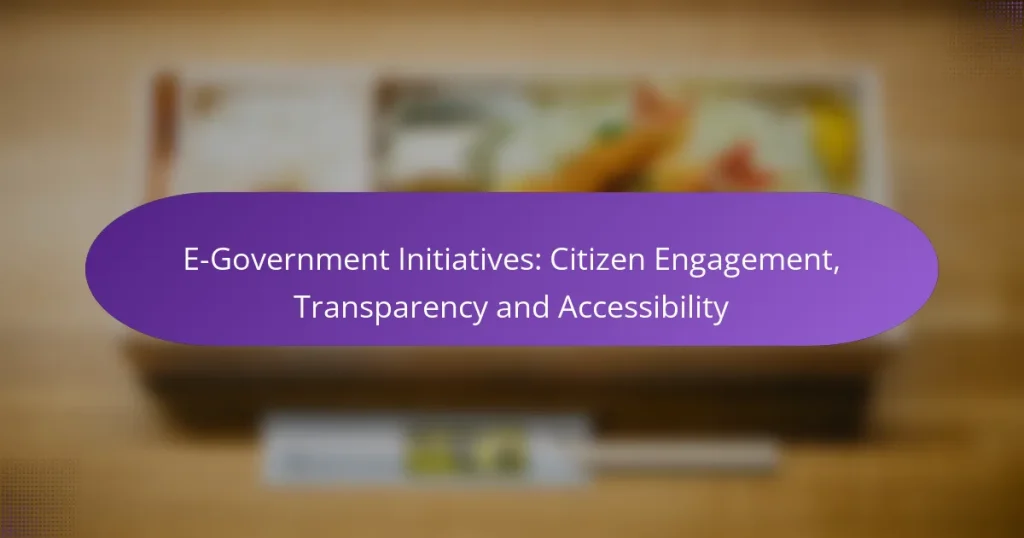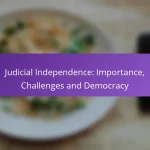E-government initiatives play a vital role in enhancing citizen engagement by creating accessible platforms for interaction and feedback. By promoting transparency and accountability, these initiatives foster trust between citizens and their government, encouraging active participation in the democratic process. Additionally, ensuring accessibility for all citizens, including those with disabilities, is essential for creating inclusive online services that empower every individual to engage with their government effectively.
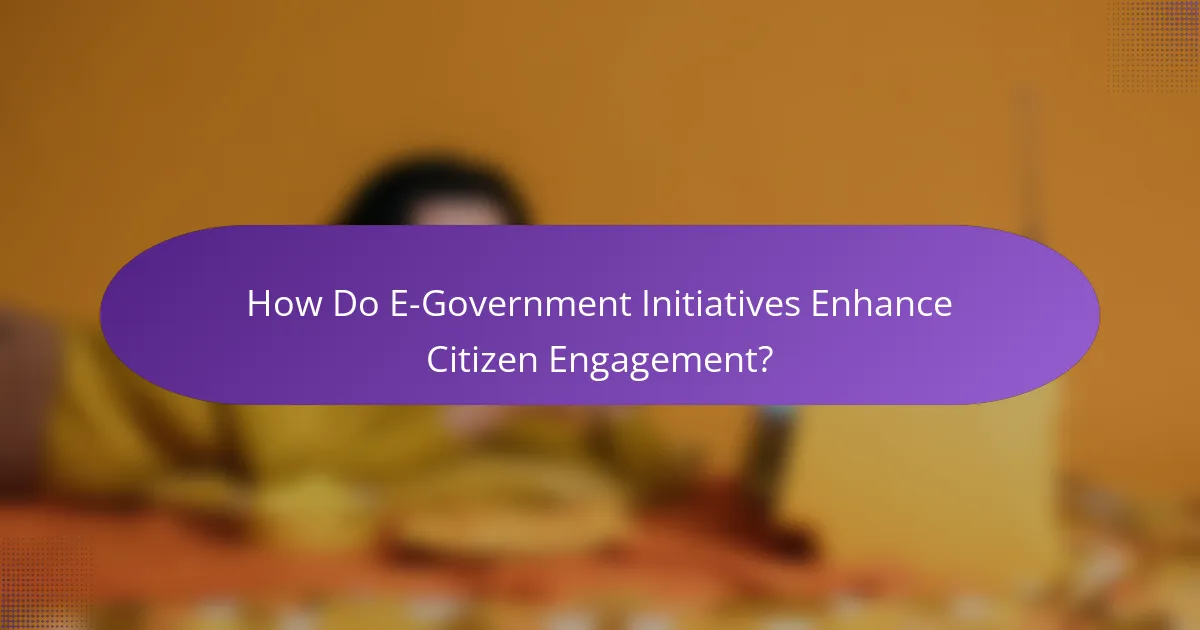
How Do E-Government Initiatives Enhance Citizen Engagement?
E-government initiatives significantly enhance citizen engagement by providing accessible platforms for interaction and feedback. These initiatives foster transparency and encourage active participation in governance, ultimately leading to a more informed and involved citizenry.
Interactive platforms for feedback
Interactive platforms allow citizens to voice their opinions and provide feedback on government services and policies. These platforms can include online surveys, forums, and dedicated websites where users can submit suggestions or report issues. By actively engaging with citizens, governments can identify areas for improvement and adapt their services accordingly.
For effective feedback collection, governments should ensure these platforms are user-friendly and accessible across various devices. Regularly updating the platforms and acknowledging citizen contributions can further enhance trust and participation.
Online town hall meetings
Online town hall meetings enable citizens to engage directly with government officials in a virtual setting. These meetings often feature live Q&A sessions, allowing participants to ask questions and express concerns in real-time. This format not only increases accessibility but also fosters a sense of community among participants.
To maximize participation, governments should promote these events through various channels, including social media and email newsletters. Scheduling meetings at convenient times and providing recordings for later viewing can also help reach a broader audience.
Mobile applications for civic participation
Mobile applications designed for civic participation empower citizens to engage with their local governments from their smartphones. These apps can facilitate reporting issues, accessing services, and receiving updates on community events. The convenience of mobile access encourages more citizens to participate in governance.
When developing these applications, governments should prioritize user experience, ensuring that navigation is intuitive and information is easily accessible. Regular updates and user feedback can help maintain engagement and improve functionality.
Social media outreach strategies
Social media outreach strategies play a crucial role in enhancing citizen engagement by providing a platform for real-time communication and information sharing. Governments can use social media to disseminate important updates, gather public opinion, and promote civic initiatives. Engaging content, such as videos and infographics, can capture attention and encourage interaction.
To be effective, governments should tailor their messaging to suit different platforms and audiences. Responding promptly to comments and messages can also foster a sense of community and trust between citizens and their government.
Gamification of public services
Gamification involves incorporating game-like elements into public services to motivate citizen participation. This can include rewards for completing civic tasks, such as attending community events or providing feedback on services. By making participation more engaging, governments can increase involvement and awareness of local issues.
When implementing gamification, it’s essential to ensure that the rewards are meaningful and relevant to the community. Clear communication about how to participate and the benefits of engagement can further enhance the effectiveness of these initiatives.

What Role Does Transparency Play in E-Government?
Transparency in e-government is crucial as it fosters trust between citizens and their government. It ensures that citizens have access to information about government operations, which enhances accountability and encourages civic engagement.
Open data initiatives
Open data initiatives involve making government data freely available to the public in a usable format. This can include statistics on public health, education, and transportation, allowing citizens to analyze and understand government performance. For example, cities may provide datasets on crime rates or public service usage, enabling informed community discussions.
To implement open data initiatives effectively, governments should prioritize data relevance and usability. Engaging with citizens to identify what data they find valuable can enhance participation and trust.
Public access to government budgets
Public access to government budgets allows citizens to see how taxpayer money is allocated and spent. This transparency helps to prevent mismanagement and corruption by making financial decisions visible. For instance, detailed budget reports can be published online, breaking down expenditures by department or project.
Governments should ensure that budget information is presented clearly, using visual aids like charts or infographics to enhance understanding. Regular updates and public forums can further engage citizens in budget discussions.
Real-time tracking of government projects
Real-time tracking of government projects provides citizens with updates on the progress and status of public initiatives. This can include infrastructure projects, community services, or public health campaigns. By using online dashboards, governments can share timelines, budgets, and milestones with the public.
To maximize effectiveness, governments should ensure that tracking tools are user-friendly and accessible on various devices. Regular communication about project outcomes can also help maintain public interest and trust.
Transparency in procurement processes
Transparency in procurement processes ensures that government contracts are awarded fairly and competitively. This can involve publishing tender documents, evaluation criteria, and the final contract details online. Such practices help to mitigate corruption and promote fair competition among suppliers.
Governments should adopt standardized procedures for procurement transparency, including clear timelines for submissions and decisions. Engaging stakeholders in the process can also enhance credibility and public confidence in government spending.
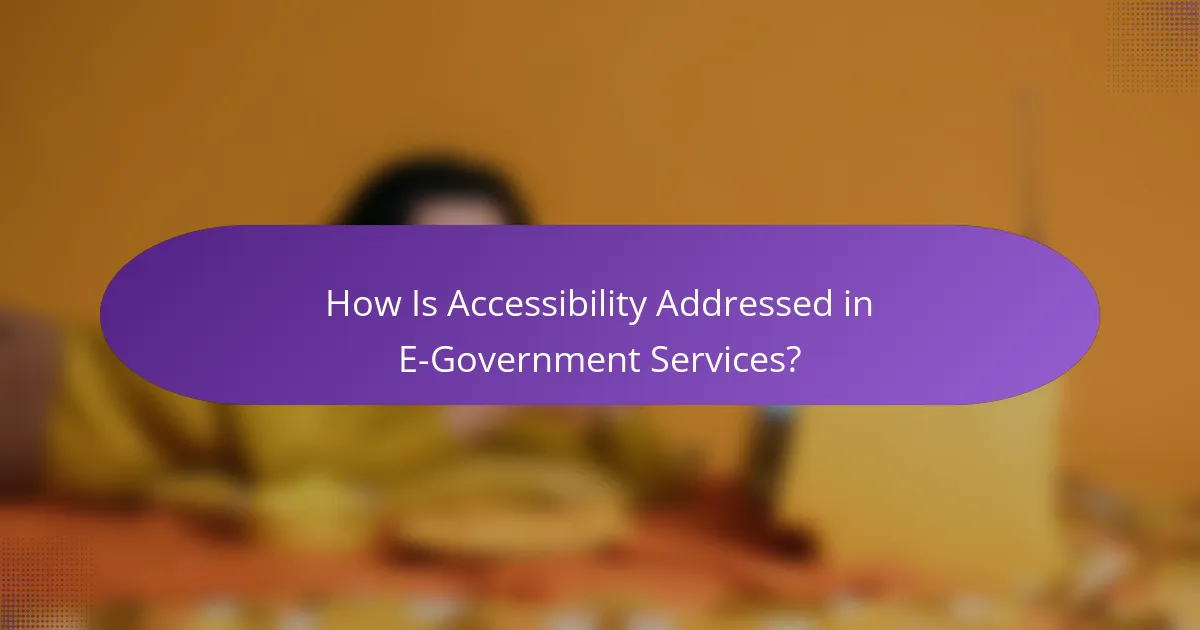
How Is Accessibility Addressed in E-Government Services?
Accessibility in e-government services ensures that all citizens, including those with disabilities, can effectively use online platforms. This involves adhering to standards and implementing features that promote inclusivity and ease of use.
Web accessibility standards compliance
Compliance with web accessibility standards, such as the Web Content Accessibility Guidelines (WCAG), is essential for e-government services. These guidelines provide a framework to make web content more accessible to people with disabilities, ensuring that websites are perceivable, operable, understandable, and robust.
Governments should regularly audit their websites for compliance and consider user feedback to identify areas for improvement. Tools like accessibility checkers can help assess adherence to these standards.
Multilingual support for diverse populations
Multilingual support is crucial for engaging diverse populations in e-government services. Offering information in multiple languages ensures that non-native speakers can access essential services and information without barriers.
Governments should prioritize languages spoken by significant portions of their population and provide clear navigation options for language selection. This can enhance user experience and increase participation in civic activities.
Mobile-friendly service delivery
Mobile-friendly service delivery is vital as many citizens access government services via smartphones. Ensuring that websites and applications are optimized for mobile devices improves accessibility and user satisfaction.
Responsive design techniques should be employed to adapt content to various screen sizes, and touch-friendly interfaces should be implemented. Regular testing on different devices can help identify usability issues.
Assistive technologies for disabled users
Assistive technologies, such as screen readers and voice recognition software, play a significant role in making e-government services accessible to disabled users. These tools help individuals with visual or mobility impairments navigate online platforms effectively.
Governments should ensure that their websites are compatible with these technologies by following best practices in coding and design. Providing training and resources for users on how to utilize assistive technologies can further enhance accessibility.
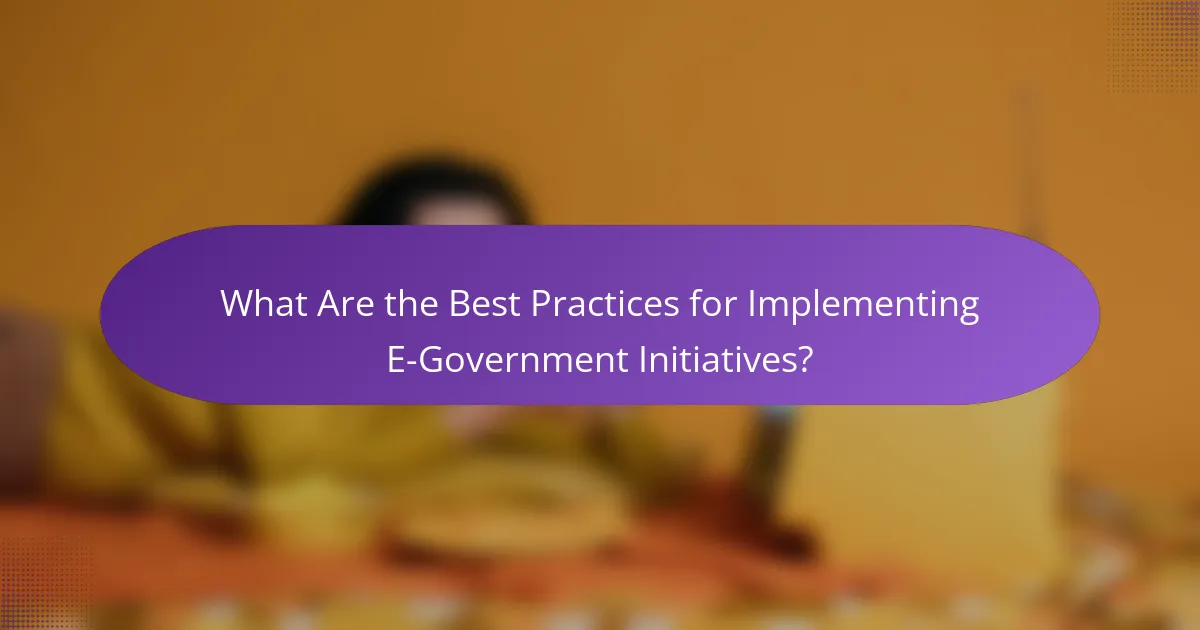
What Are the Best Practices for Implementing E-Government Initiatives?
Best practices for implementing e-government initiatives focus on enhancing citizen engagement, ensuring transparency, and improving accessibility. These practices involve user-centered design, effective stakeholder engagement, and robust data privacy measures.
User-centered design approaches
User-centered design is essential for creating e-government services that meet the needs of citizens. This approach involves understanding user requirements through research, testing, and feedback, ensuring that services are intuitive and accessible.
For example, conducting usability testing with diverse user groups can help identify barriers and improve the overall experience. Aim for designs that accommodate various devices, ensuring that services are mobile-friendly and accessible to all demographics.
Stakeholder engagement strategies
Engaging stakeholders, including citizens, government employees, and community organizations, is crucial for successful e-government initiatives. Regular consultations and feedback sessions can foster collaboration and ensure that diverse perspectives are considered in the planning process.
Utilizing online platforms for surveys and forums can facilitate ongoing dialogue. Additionally, forming advisory groups with representatives from different sectors can help align initiatives with community needs and expectations.
Data privacy and security measures
Implementing strong data privacy and security measures is vital to build trust in e-government services. This includes adhering to regulations such as the General Data Protection Regulation (GDPR) in Europe, which sets strict guidelines for data handling.
Governments should employ encryption, secure access controls, and regular security audits to protect sensitive information. Educating citizens about their rights and how their data is used can further enhance transparency and confidence in e-government systems.
